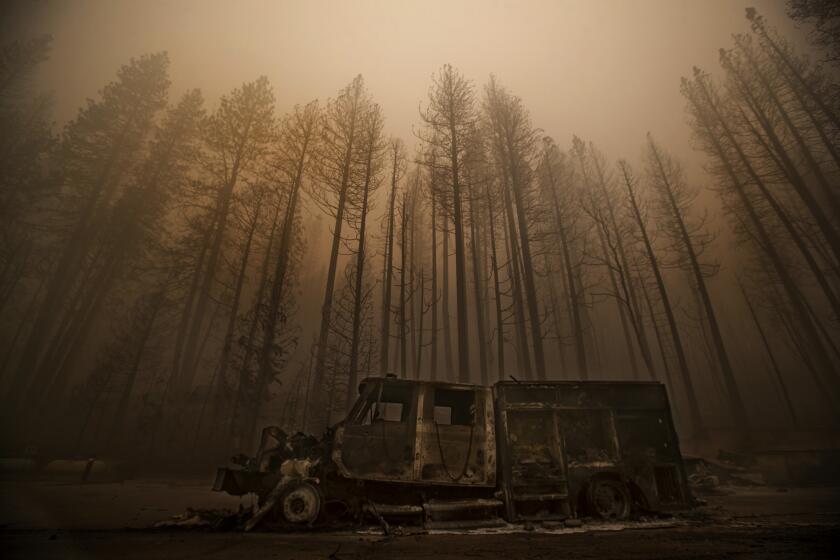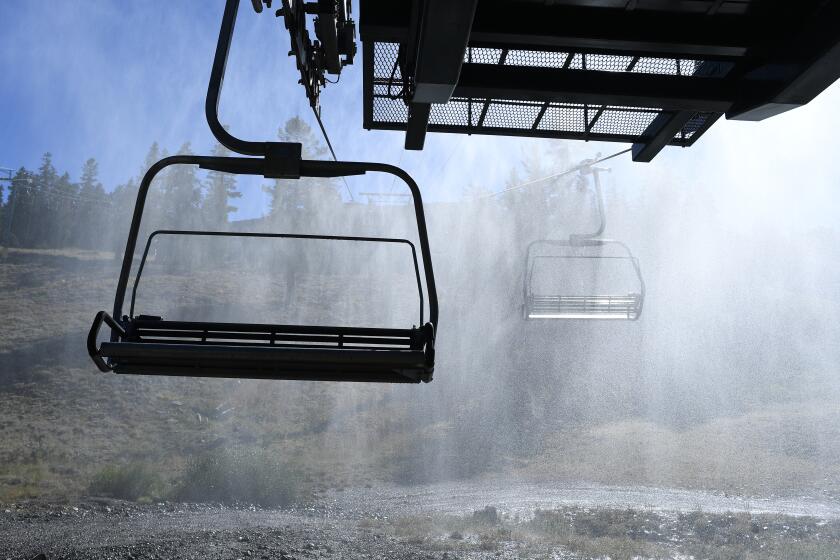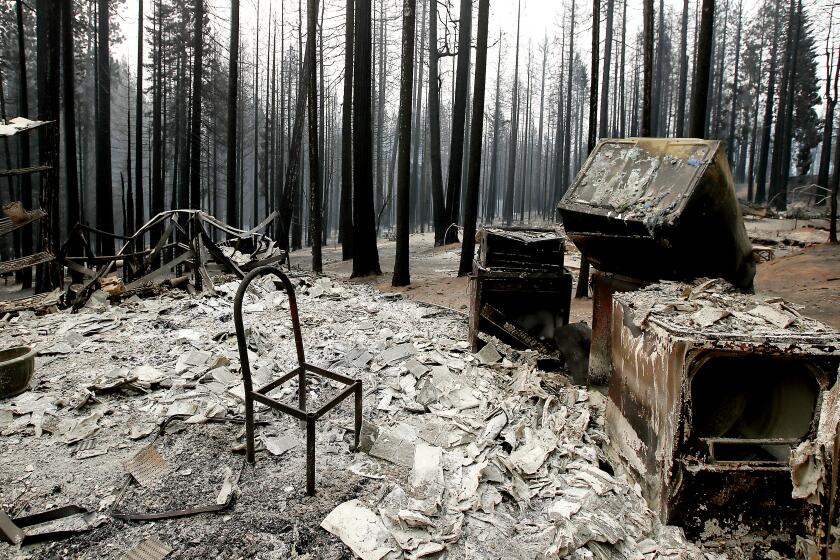Prescribed burns are key to reducing wildfire risk, but federal agencies are lagging
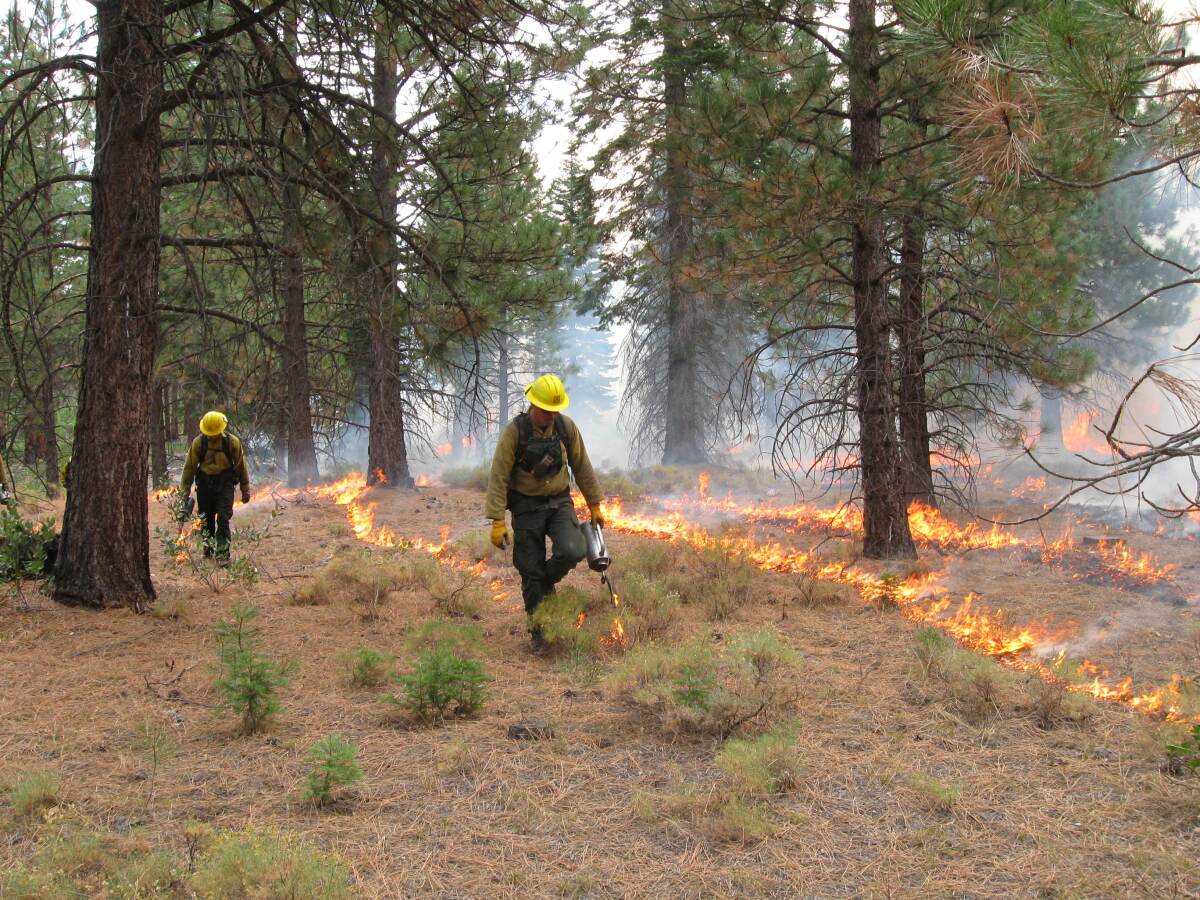
When wildfire burned through a federal research area in Klamath National Forest this summer, scientists were dismayed to see more than 20 years of work go up in smoke.
But when they returned to the charred study area near California’s northern border, they realized they’d been given a unique opportunity.
For the record:
3:26 p.m. Nov. 12, 2021A previous version of this article said the U.S. Bureau of Land Management plans to perform 300 acres of broadcast burning in California this calendar year but has yet to begin. The agency has performed 214 acres of broadcast burning this calendar year.
Although the scientists had set out to understand how the thinning and controlled burning of vegetation could help regrow large trees more quickly, they now had a chance to study another urgent question: Could these same treatments make forests more resilient to wildfire? Or more specifically, could they moderate fire behavior so that flames were less intense and firefighters would have a better chance of snuffing a blaze before it barreled into a populated area?
The answer appeared to be a resounding yes.
“In areas where we didn’t do anything, the untreated controls, the predominant fire behavior was a crown fire which killed every tree and consumed the entire tree crown,” said Eric Knapp, research ecologist with the U.S. Forest Service.
However, the plots that had been thinned and then treated with broadcast burning — in which an area of land is set alight to mimic naturally occurring wildfire — emerged relatively unscathed, he said.
The results, once confirmed, will rank among the strongest scientific evidence supporting the effectiveness of these so-called fuels treatments, Knapp said. But they were not unexpected. Researchers have found in the past that the best outcome is reached by the combination of thinning crown fuels, or tree canopy, and burning surface fuels, or vegetation on the ground.
Despite this knowledge, however, the federal government, which manages about 57% of the forested land in California, has completed only half of the fuels treatments it had hoped to get done in the state for the year — a statistic that profoundly dismayed wildfire experts.
As of mid-September, the Forest Service had completed or contracted out fewer than 37,000 acres of prescribed fire projects in California since Oct. 1, 2020. The majority was the burning of stacks of vegetation that had been piled after thinning, in which crews prune branches or cut down smaller trees, often using chain saws or cranes.
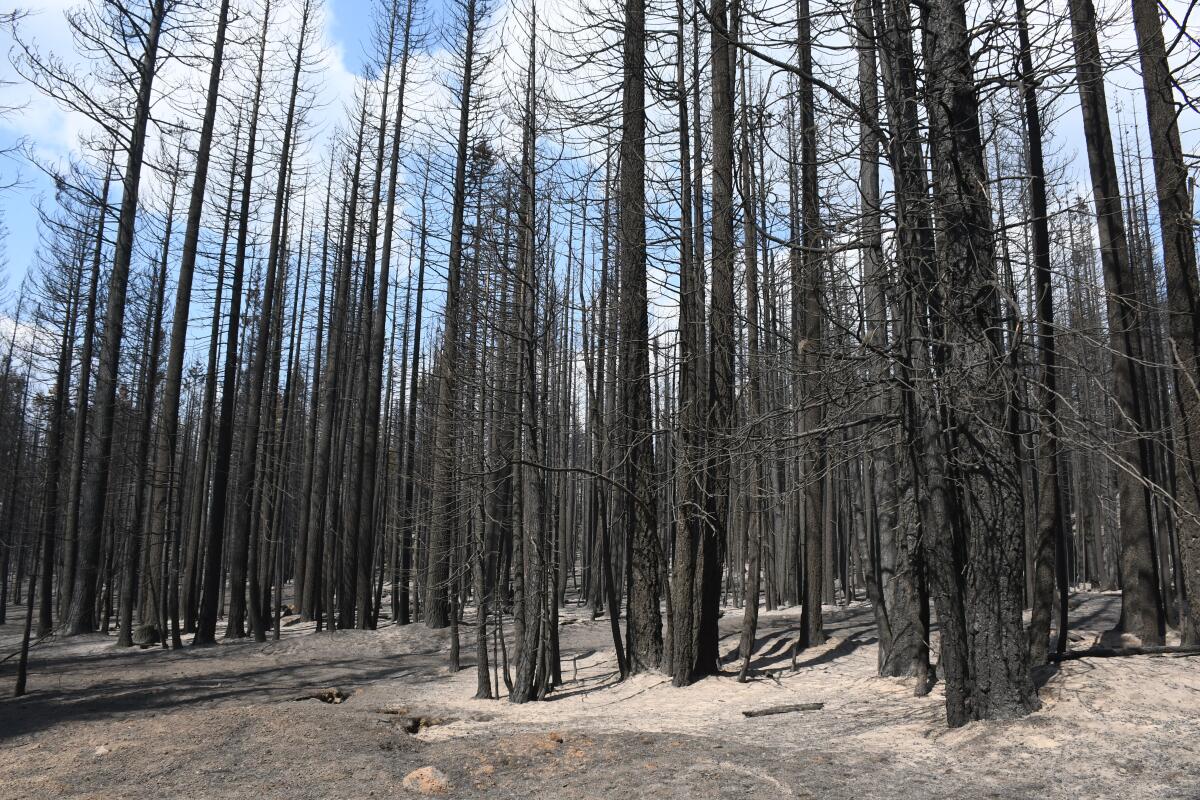
An additional 6,063 acres of managed land included naturally ignited fires that were allowed to burn — a practice the Forest Service suspended after it came under heated criticism over the summer.
Another 5,000 acres were treated with broadcast burning, which in combination with thinning has shown to be most effective.
“That’s just depressing,” said Lenya Quinn-Davidson, fire advisor for the University of California Cooperative Extension. “That’s so little, given how much land the Forest Service manages in California. It is just a drop in the bucket.
“I think it speaks to the need for such drastic change around prescribed fire.”
In total, the Forest Service had, as of Sept. 17, met about 54% of its goal of treating 238,200 acres in the state during the fiscal year, which ended Sept. 30. The target does not discriminate between prescribed burning and other methods of vegetation removal. Those include grazing, thinning, chemical treatments such as herbicide, and disposing of the thinned vegetation, including biomass removal, chipping, crushing and piling.
The U.S. Bureau of Land Management and the National Park Service, which manage much less forested land in California, didn’t fare any better. The NPS performed a total of 616 acres of broadcast burning in the state so far this calendar year; the BLM has burned 214 acres of a planned total of 300.
Officials say the lag in forest treatment is due to several factors, including lack of funding and personnel, but also to fundamental changes in the fire season. They say that drought, climate change and fuel overloading have stretched out the season and narrowed the time frame in which prepared burns can be conducted.
“There’s a lot of structural issues that need to be overcome to burn at the scale that is needed,” Knapp said.
::
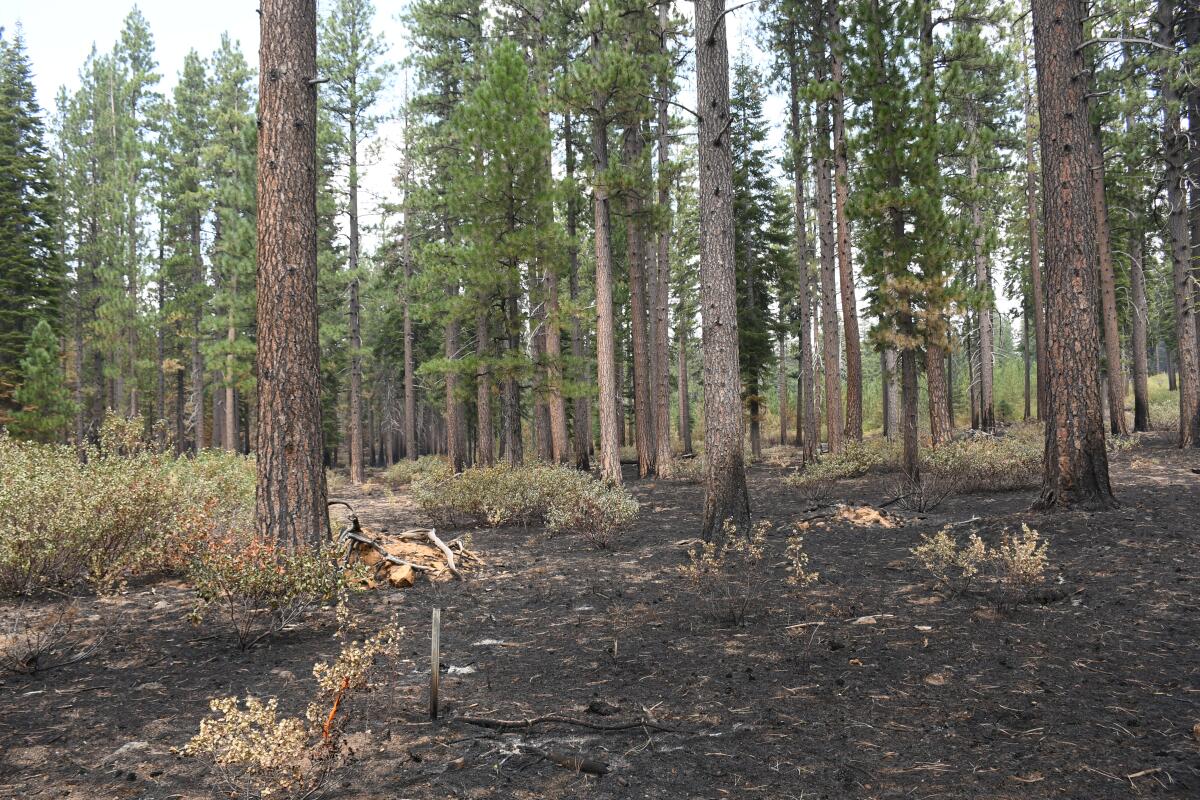
The Klamath study, dubbed the Goosenest Adaptive Management Area, is a patch of old timberland that was heavily logged before it was turned over to the Forest Service in the mid-1950s. Before it was privately managed, fires had burned through the area every nine years or so, but by the time researchers began to focus on the area, it had not burned in decades, Knapp said.
The parcel was crowded with young trees competing for light and resources, and they had transitioned from primarily pine to fir, which is less fire- and drought-tolerant, he said.
Scientists were trying to see if they could remove some vegetation to re-allocate the growth to fewer trees, making them grow larger more quickly and restoring the forest to something that more closely resembles what it looked like a century ago.
They put in place three treatments: thinning favoring the reestablishment of pine species; thinning favoring pine species plus two rounds of broadcast burning, in 2001 and 2010; and thinning favoring the largest-diameter trees with no regard to species. Each was repeated on five 100-acre plots. Five control plots received no treatment.
The lightning-sparked Antelope fire burned through all of the plots over the course of four days starting Aug. 4.
“Because we have five replicates of each of these treatments that were all hit by fire burning under oftentimes similar conditions, we can tease out the effect of weather and the effect of fuels,” Knapp said. “It will be a very compelling example of the interaction of fuels treatments and weather in affecting the outcome.”
Initial observations suggest that the plots that were thinned and burned fared the best, the control plots the worst, and the plots that were only thinned made out somewhere in the middle. There was little noticeable difference between the two types of thinning.
“What it shows to me is that under the most extreme fire behavior, thinning alone is oftentimes not enough,” Knapp said. “You have to also deal with the stuff on the ground.”
New study says climate change is essentially two-thirds to 88% responsible for the conditions driving wildfire woes in the western United States.
That’s not to say thinning alone didn’t change fire behavior, he said. Though many of the trees in the thinned plots still died, they were killed by heat, their needles scorched brown. By contrast, the trees in the control plots were entirely consumed by fire, leaving behind only dead, blackened sticks.
That suggests the thinned plots experienced a hot surface fire. The control plots, however, experienced even hotter fire that reached up into the crowns and burned the canopy, likely spitting out embers ahead of the main fire that made it move more quickly, Knapp said. Such variations in intensity and speed could mean the difference between firefighters being able to battle the fire or being forced to retreat.
::
Traditionally, parts of California would get a rainstorm in late September or early October, and broadcast burning could start a couple of weeks later once the vegetation dried out, Knapp said.
But in the last few years, fall rains haven’t arrived until late October or November. By that time, the sun angle is so low on the horizon and it’s so cool that the rain-soaked vegetation might never dry to the point where these burns can be conducted, he said. And even once the right conditions are in place, fire smoke and air quality considerations limit the number of burns that can be performed at once, Knapp added.
At the same time, fire seasons have grown longer and more intense, so the crews that once transitioned from fighting blazes to setting them are no longer available because they are still in fire suppression mode.
Officials credited aggressive firefighting, improved weather conditions and past efforts to prepare for wildfire with saving the resort town.
The National Interagency Fire Center reached its highest preparedness level, 5, in July, the earliest point in a decade. The designation indicates that 80% of the nation’s wildland firefighting personnel are committed to incidents.
U.S. Forest Service Chief Randy Moore cited those resource limitations in August when he announced the agency would no longer consider conducting prescribed burns until the preparedness level dropped back down to 2.
“We are in a ‘triage mode’ where our primary focus must be on fires that threaten communities and infrastructure,” he wrote in a memo explaining the decision.
The move underscored the dire need for a full-time workforce dedicated solely to prescribed burning, with positions that are well-paid and attractive, Quinn-Davidson said.
“We need more jobs focused on prescribed fire and fuels treatments that don’t get pulled off to fire suppression,” she said.
::
Authorities caution that many Western U.S. forests have suffered through so many years of imbalance due to aggressive fire suppression practices and climate change that broadcast burning alone is not sufficient to restore them.
National forests like El Dorado are now so overgrown that the landscape often must receive one or more rounds of thinning before it is safe to put fire on the ground, said Jeff Marsolais, forest supervisor of El Dorado, which has seen no prescribed burning this fiscal year.
“Getting to where we can broadcast burn and having fire burn naturally through the ground like it did 100 years ago, that’s exactly what we’re trying to get to,” he said. “But there’s a ton of work that has to go into restoring the resilience of the forest before we can get to that level.”
For many residents in Northern California, summer has now become a time of dread due to extreme wildfires.
And even if federal authorities were able to perform these treatments on the scale that is needed, the increasingly extreme conditions under which fires are burning still means they wouldn’t always be sufficient to protect forests and communities from damage.
In a development that surprised researchers on the Goosenest study, one of the units treated by thinning and prescribed fire that burned during a four-hour high wind event appears to have been fairly heavily damaged despite the low surface and crown fuel loads, Knapp said.
“To me, this illustrates there may be some limits to what treatments can do under severe fire conditions,” he said. “Maybe when we’re up against the worst conditions, you just can’t really do much to prevent that.”
Still, he said, high wind events tend to be of limited duration and account for a minor portion of the time during which a fire burns. And treatments can slow the spread of the blaze so that less land burns under those extreme conditions, he added.
The plot was also overdue to receive another round of prescribed fire, underscoring the importance of maintenance. And it still fared better than the control plots that burned under the same weather conditions, he said, estimating that 25% to 50% of the trees will survive.
“So even in the worst conditions, it did something that made the forest more resilient,” he said. “Just maybe not as resilient as we would’ve hoped.”
More to Read
Sign up for Essential California
The most important California stories and recommendations in your inbox every morning.
You may occasionally receive promotional content from the Los Angeles Times.
